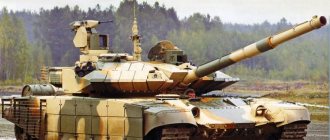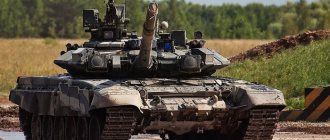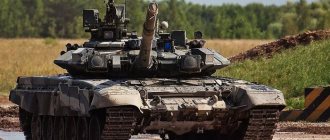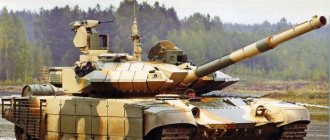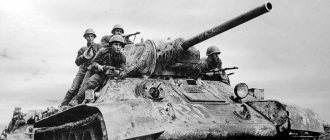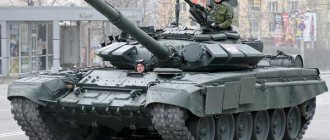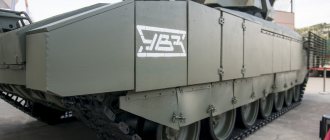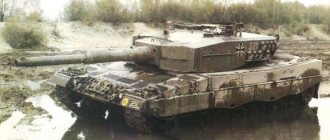The classification of tanks has changed the terminology several times throughout the history of their use. One such term is main battle tank, which refers to a multi-purpose vehicle that combines high striking power, mobility and armor. It is this type of equipment that becomes the basis of tank formations in large-scale operations.
In the Russian classification, two terms are known - main tank and special. The first type coincides with Western classifications. A special vehicle is a single-purpose vehicle used for specific types of troops or tasks.
“Black Eagle” is a Russian main tank project developed in the 1990s by the Omsk Transport Engineering Design Bureau. Also known as "Object 640". It was assembled only as a prototype and was not released into mass production.
New armor steel
Several years ago (for the first time in 30 years, by the way), a new armor steel was developed in Russia (developed by the Steel Research Institute). The new steel grade 44S-sv-Sh will be used instead of traditional serial armor steels in the Armata tank and other vehicles based on it. The steel was obtained thanks to the balanced composition of carbon and the main alloying and carbide-forming elements, as well as the peculiarities of the technology of its smelting, rolling and heat treatment at the end. Thanks to unique production secrets, it was possible to achieve good control over the purity and final structure of the armor alloy. The result is a harder alloy (54 Rockwell hardness units versus 45-48) while maintaining the same plastic and elastic characteristics. The increase in armor resistance of the new alloy was about 15% compared to the existing one. The use of new steel will free up several additional tons of tank weight while simultaneously increasing the level of protection. But it is not yet known whether this steel will be used to produce the entire tank or only for the crew capsule and individual parts. Steel does not lose its properties at very low temperatures and can be used in northern latitudes, for example in the Arctic. Welding steel does not pose any problems, which facilitates production and repair.
25 mm sheet of new steel after successful testing with a 12.7 mm caliber B32 armor-piercing bullet. Source https://niistali.ru At the moment, steel is at the stage of pilot industrial development, that is, several more technical issues need to be resolved before mass production begins. In the future, steel can also be used to modernize outdated armored vehicles, for example, as additional armor linings on the main armor or for the manufacture of individual armor elements.
Dynamic protection
Almost nothing is known about dynamic protection at the moment. According to some sources, the protection is called Malachite and it will be superior to the Relikt modular type ERA that is found on the most modern Russian T-90AM (SM) tanks. The protection will be able to withstand the most modern basic ammunition, such as tandem cumulative and armor-piercing sabot rounds.
Additional systems As additional protection systems, the tank will have an optical-electronic suppression system of the “Curtain” type, a smoke screen system connected to a laser irradiation warning system.
Chassis
The chassis of the tank is made according to a seven-support design using caterpillar tracks. Each belt is equipped with two removable extensions, installed, respectively, on the outside of the tank and on the inside. The extensions are bolted into the brackets (extreme links) of the track. With the extensions removed, the average specific pressure on the ground is ensured in the range of 0.87-0.9 kg/cm2, i.e. at the level existing on modern tanks.
With installed expanders, the average specific pressure on the ground is ensured in the range of 0.80-0.81 kg/cm2, i.e. optimal from the point of view of cross-country ability on soils with low bearing capacity. The dimensions of the tank “f” along the tracks with extenders installed on the tracks exceeds the railway dimensions, however, removing the external extensions makes it possible to reduce the dimensions of the tank along the tracks and transport the tank on railway platforms.
The use of removable extenders in the tracks allows, when transporting a tank, to remove the extenders from the outer sides of the tracks by unscrewing the bolts on the outer brackets, thereby keeping within the railway gauge and ensuring the transportation of tanks by rail, and, if necessary, entering into battle immediately after leaving the railway platform . At the same time, the installation of extensions ensures maneuverability on soils with low bearing capacity.
Firepower
The armament is located in an uninhabited robotic combat compartment and is controlled by the crew remotely from the control capsule. 125mm high-power gun 2A82 It is planned to install a high-power 125mm caliber gun under the symbol 2A82 on the tank. It was developed in the 2000s, tested and put into production in 2013. Compared to existing serial guns (2A46 series) mounted on the T64-72-80-90, the 2A82 gun has on average 30% higher muzzle energy while almost completely maintaining the same dimensions and weight (except that the barrel has become almost longer meter). The superiority over the serial 120mm tank gun (L44 and L55) is about 15% in terms of muzzle energy. (USA-M1 Abrams, Germany tank Leopard 2A6, 2A7, Turkey-promising Altai tank)
125mm cannon 2A82 compared to 2A46. Source https://www.russianarmor.info
Presumably, some differences of this gun are an enlarged charging chamber that allows you to place a more powerful powder charge and a more durable barrel material that allows you to withstand higher pressure when fired and thereby give the projectile a higher flight speed. As a result, the effectiveness of armor-piercing projectiles increases, as well as the range and the accuracy of artillery fire. Presumably the initial speed of an armor-piercing projectile is 2000 m/sec.
The creation of this gun required designers and manufacturers to master the most advanced technologies, such as the production of new barrel steel and special thermomechanical treatment of the gun barrel. An auto-bonding process was used in the production of the barrel. This is a mechanical treatment of the inner surface of the barrel, after which the inner layers are subject to compression load, and the outer ones. This process increases rigidity and resistance to deformation, which allows increasing the pressure when fired. The barrel is partially chrome-plated inside to increase service life and survivability.
The gun can fire all types of existing 125mm ammunition (for 2A46, 2A75, etc.), as well as especially powerful ammunition developed specifically for it. This was one of the main requirements of the Ministry of Defense due to the already established production of 125mm shells and a large number of them in warehouses. In the future, this gun can be used to modernize aging armored vehicles such as T72, T80, T90 and similar vehicles.
The figure shows in red the dimensions that a weapon system based on the 2A82- and in blue the existing 2A46 will take. Source https://gurkhan.blogspot.com
The main ammunition is placed in the turret automatic loader. There is an additional automatic loader behind the turret for armor-piercing ammunition of increased power (they are longer and will not fit into a standard turret automatic loader. The ammunition load is approximately 40-45 rounds (including guided anti-tank and even anti-aircraft missiles). In the future, the 125mm cannon can be replaced with a 152mm 2A83 ( as on the T-95) to further increase firepower.
Secondary weapons The cannon will be paired with a 7.62 caliber machine gun. The total ammunition load is 2000 rounds. There is nothing special to write here since this is, in principle, standard for almost all tanks of the USSR / RF. The turret is equipped with a 30mm 2A42 or 2A72 automatic cannon for hitting low-flying targets, light armored vehicles and infantry. The ammunition load is supposedly 300-400 shells (armor-piercing and fragmentation). There will also be a 12.7mm anti-aircraft gun with remote control. It will have the ability to automatically shoot down missiles approaching the tank after receiving a signal from the radar. It is planned to install a 30 or 57 mm automatic grenade launcher on the tank. As you can see, the choice of weapon options is wide, which significantly increases firepower and the list of tasks to be solved.
Layout
I will assume that the most possible option is a layout like on the T-95 tank. The control compartment with the crew is located behind a powerful armored package in front, in a special armored capsule and is separated from the combat and engine-transmission compartments located behind it by a special armored partition. This significantly increases the chance of crew survival if the tank is damaged and fuel or charges catch fire. In the event of an ammunition detonation, the main energy of the explosion comes out through special expulsion armor panels in the tank hull.
Proposed layout of the new tank. 2 automatic loaders are visible. A turret one for standard shells and a turret one for high-power (extended) ammunition. Source https://vpk.name
According to another, in my opinion, unlikely version, the engine is located in front, and behind it in a special armored capsule is the crew, then behind the partition is the robotic combat module. There is even room for a small landing force or additional equipment. The engine in this case provides additional protection at the front, following the example of the Israeli Merkava tank.
One of the proposed appearances of the Armata tank with a front engine. Source https://pro-tank.ru
It is planned that the armored control capsule will be the same for other vehicles of the Armata project (infantry fighting vehicles, self-propelled guns, etc.).
Description of design
The development of the Black Eagle tank was based on the concept of using this technology in local conflicts. According to the developers, it is due to a decrease in the likelihood of large-scale combat operations with the advance of large tank units.
Taking this aspect into account, a modern tank must have good transportability for transfer to a given region, combine maneuverability and rapid deployment. The main problem for this was the need to reduce weight due to the armor and turret, which affected the survivability of the tank.
A special feature of the body of this vehicle is the presence of armored partitions dividing it into three compartments. The entire crew is located below the tower level in the habitable compartment. The seats are adjustable, there is a traveling position and a combat position. To leave the vehicle, each crew member has his own hatch - in the hull for the driver and two in the turret for the commander and gunner.
Department of Management
The control compartment is located at the front in accordance with the classic layout. The key difference is the division into three compartments. The driver occupies the middle position; on either side of him behind armored partitions there are fuel tanks. The design reliably protects the crew from their explosion.
Combat compartment
The fighting compartment also has a non-standard layout. The gunner's and commander's positions are located in the middle part, in the combat position no higher than the turret shoulder strap. The crew is protected from the explosion of ammunition and the removal of powder gases. Loading the gun is automated.
Tower
The design of the tower provides all-round protection from shells, and also takes into account the possibility of being hit from above. Because of this, the tower is reduced in size and divided into two compartments. The front part has an angle of 20-30 degrees, which reduces the likelihood of damage.
Taking into account the dimensions and layout of the turret, its protection has been increased by 1.7-2 times with directional fire of 35-40 degrees. The total weight has been increased to only 30%, which is considered the optimal combination to ensure the survivability of the tank.
Protection against damage from above ensures that the turret is resistant to targeted parachute cluster projectiles. The armor can also withstand attacks from anti-tank missile systems such as Bill-2 and Javelin.
Levels of protection
To maintain the transportability of a tank, its optimal weight is considered to be up to 50 tons. This figure is often achieved by reducing the ammunition load and armor protection, which ultimately affects the combat capabilities and survivability of the vehicle.
"Black Eagle" has three levels of protection:
- traditional armor is considered the key passive defense of a tank, protecting its hull and turret;
- active destruction of projectiles;
- radar detection and suppression of enemy assets.
The tank's armor is traditionally differentiated. The greatest protection is on the front and nose sheets, less on the sides. At the same time, the side armor also increases in the bow. Vertical armor plates to protect the crew are made with anti-fragmentation and anti-radiation lining.
The second level includes active dynamic protection with firing elements of the Drozd-2 type. Such a system detects and engages projectiles at a distance, excluding hits on the vehicle.
For this purpose, the hull is equipped with mortars, each with its own firing sector. Damage radii overlap and allow projectiles to be fired around the entire circumference. Detection is provided by a radar system, the control unit of which is located at the commander and gunner.
The general operation of protection systems implies the following scheme:
- the Shtora radar complex detects enemy surveillance equipment or laser irradiation for the purpose of guiding a projectile;
- the crew is informed about the attack, automatic or command launch of an aerosol grenade is allowed;
- the aerosol disrupts auto-guidance, complicates the search for a target with guided ammunition and the operation of anti-tank systems;
- if a projectile is launched, the Drozd system comes into effect, the target is detected and hit by a fragmentation field at a distance safe for the tank;
- the last level is tank armor, including mounted units with dynamic protection.
If the armor is penetrated, crew survivability is ensured by the tank's layout and internal armor plates. The energy of the explosion is directed upwards and to the sides; for this there are special ejection hatches. Crew protection is also provided in the event of an explosion of ammunition or fuel tanks.
Active protection complex (APS) Afganit
KAZ "Afganit" developed by Kolomna KBM. According to patent RU 2263268, the new generation complex is as follows. A directed explosion charge (cumulative with the formation of an impact core) is placed on the tank hull, on a high-speed rotary installation. A special radar monitors the appearance of objects flying towards the tank, determines the speed and size of the object, then, through the control system, deploys and detonates the charge in the direction of the threat (ATGM/ATGM missile, artillery shells). When a shaped charge is detonated, a so-called impact core is formed, which hits a flying object at a distance of 4-5 meters from the tank.
Estimated type of protective projectile of the Afghanit system. Source https://topwar.ru
The number of protective charges placed on the tank is unknown. The speed of the impact core after formation is 2-2.5 km/sec, which, when combined with a sensitive radar, makes it possible to shoot down ammunition flying at speeds of up to 1700 m/sec. In the future, it is possible to create a system for shooting down targets flying at speeds of up to 2600-3000 m/sec.
Why did work on the prototype stop?
After 1999, the Black Eagle tank was no longer publicly displayed. No one announced its acceptance either. Due to the lack of orders from the Ministry of Defense, the Omsk plant went bankrupt in 2005. It is this aspect that is considered the reason for the cessation of development.
In 2009, an official statement from the Ministry of Defense appeared that the Black Eagle tank does not exist. All developments in this direction were aimed at creating the “Armata”, which is why “Object 640” is considered one of its predecessors.
Radar based on an active phased array antenna (AFAR)
Armata will be equipped with radars of the same type as those of the projected fifth-generation fighter T-50. These will be radars based on an active phased array antenna (AFAR). AFAR is a set of hundreds of microwave transmitters. The antenna can quickly change the location direction (no need to rotate the locator “dish”). The antenna is very reliable and the failure of one or more of the elements (when penetrated by a bullet or shrapnel) does not lead to failure of the radar, which is an irreplaceable quality in combat conditions. Such a radar will be used both defensively and offensively. It can be used as part of a fire control system and as part of an active protection complex that detects ammunition approaching the tank. (It will be possible to work together with the Afghanit complex) The system is capable of simultaneously “leading” up to 25 aerodynamic targets and identifying targets up to 30 cm in size within a radius of up to 100 km. Presumably these are the maximum parameters that can be set if the customer wishes.
Advantages and disadvantages
Aft
The advantages of the experimental tank include:
- good driving performance;
- comprehensive three-level machine protection;
- protection of the crew from projectiles and explosions;
- automated gun loading.
In addition to these qualities, the tank is repairable. Most aspects are made using a modular system, which allows you to quickly change components, returning the machine to service.
The disadvantages of "Black Eagle" have not been identified. The tank was assembled in a single copy and was not put into mass production. Also, no large-scale tests were carried out that could reveal design flaws.
Many people still argue about the prospects of this project, considering a number of technical characteristics to be overestimated and not corresponding to reality, especially in the absence of state tests. However, in 2011, it was officially announced that a number of developments from this project would be used in the creation of “Armata”.
Author of the article: Parpurin Vadim
Tank Black Eagle – video
https://youtube.com/watch?v=ka4PE9A9bD8
The prototype was first demonstrated in 1997 and was a modified chassis of the T-80U tank with a new design turret installed on it. Subsequently, a prototype was created with a turret mounted on a seven-roller chassis. Not mass produced. During demonstrations of prototype tanks at exhibitions, the tank's turret was always covered with a dense camouflage net.
Design
The tank chassis is a modified T-80U chassis. The hull was lengthened, which made it possible to significantly strengthen the upper frontal part and eliminate the weakened area in the area of the driver's periscopes. The tank hull is divided into three sealed compartments, isolated from each other by vertical armored sheets, which are installed along the longitudinal axis. Fuel tanks are located in the side compartments. In the central compartment there is a control compartment connected to the fighting compartment. Seats for crew members are located in the tank hull below the turret level. Access to them is through the commander's and gunner's hatches in the turret body and the driver's hatch in the tank's body. The crew seats are equipped with adjustable seats that have two positions: traveling and combat. When the seats are moved to the firing position, the crew is below the level of the turret ring. In the traveling position, the gunner and commander of the tank are located in the hull and turret.
On the side of the fuel compartments, the vertical armored sheets of the hull are covered with plates of anti-radiation material, and on the side of the control compartment and fighting compartment - with plates of anti-fragmentation material. The ammunition is located in an automatic loader installed in the turret niche and made in the form of a removable armored module with ejective armor panels that are triggered in the event of detonation. The welded tower is of a fundamentally new type. It is made in the form of two symmetrically spaced armored compartments, rigidly attached to a common base. The compartments are formed by spaced apart and coaxially located internal and external side walls, made along the front contour in the sector from the embrasure to the transverse axis of the tower in the form of truncated pyramids.
The project included arming the tank with a 125 mm cannon, a coaxial 7.62 mm machine gun and a remote anti-aircraft gun with a 12.7 mm Kord machine gun.
With a combat weight of 48 tons, the tank was supposed to be equipped with a new gas turbine engine with a power of more than 1500 hp. Thus, the specific power of the tank exceeded 30 hp/t and, as a consequence of this, the dynamic characteristics of the Object 640 should have significantly exceeded the characteristics of Western third-generation tanks, which had a specific power of 20 - 25 hp/t.
Project prospects
According to representatives of the Ministry of Defense of the Russian Federation, mass production of the promising Object 640 tank is not planned. Nevertheless, the solutions developed on this model will serve as a significant foundation for the modernization of existing tanks. For many years, reports have repeatedly appeared in the media about the progress of development and testing of the Black Eagle tank, but no details were provided about the timing and plans for launching mass production. However, on September 12, 2009, the acting head of the military-scientific committee of armored weapons and vehicles of the Ministry of Defense of the Russian Federation, Colonel Vladimir Voitov, stated that the Black Eagle tank, called a fourth or even fifth generation armored vehicle and also known as the Object 640, , does not exist.
On April 28, 2011, the former first deputy of the Main Armored Directorate of the Russian Ministry of Defense, Major General Yuri Kovalenko, announced that the developments of the Black Eagle would be used in the new main battle tank Armata.
History of creation
Model of the “Black Eagle”
The development of the “Black Eagle” tank was carried out in conditions of increased secrecy. There is no exact information about the start of work on the project; according to some sources, it has been carried out since the late 1980s. The first demonstration took place in 1997, but the performance characteristics of the tank were not disclosed, and the tank itself was demonstrated at a distance, hiding its turret with a camouflage net.
The prototype was shown again in 1999, but information about it was also hidden. This did not stop the media and ordinary observers from building theories about the exclusivity of the new technology. In the early 2000s, the creation of a new T-95 was announced, which many associated with the ob. 640.
Engine
The power plant for the Armata will be an X-shaped, 12-cylinder 1200-horsepower turbodiesel A-85-3A (also designated 12N360). The rated engine power is 1500 hp. but it was reduced to 1200 hp as this is quite enough for a new car. Thanks to the reduction in power, the engine's service life was increased (the operating time before major overhaul was about 2000 hours). There was a reserve for future boosting of the diesel engine. The engine was developed by the Chelyabinsk design bureau "Transdiesel", and production is planned at the Chelyabinsk Tractor Plant. In terms of specific power (hp per kg of weight or m3), the engine is one of the best. If necessary, it is possible to operate on different types of fuel, such as kerosene or motor gasoline. It is also planned to install a 12-speed automatic transmission, which, if necessary, can be controlled manually. (a sort of tiptronic for a tank). Presumably, the engine and gearbox will be combined into a single power unit (monoblock) for ease of replacement.
The tank will have an auxiliary generator to power on-board systems and charge batteries while parked or in an ambush. Thus, there is no need to start the main diesel engine, fuel is saved, the noise and visibility of the tank is significantly reduced, and the life of the main engine is also saved.
X-shaped, 12-cylinder 1500-horsepower turbodiesel A-85-3A (12N360). Source https://gurkhan.blogspot.com
For operations in the Arctic, the Armata platform may in the future be equipped with a gas turbine engine (GTE). Compared to a diesel engine, a gas turbine engine has some advantages in cold climates: 1) Ease of starting at low temperatures (down to –40°C) 2) As a result of point 1, higher operational readiness. 3) No large power consumption for the cooling system. 4) Smooth control, change of operating mode and, as a result, improved cross-country ability on soft soils.
As an option, we can assume the installation of a GTD-1250 (as on the existing T-80U). The engine is already well mastered in operation and production. At the end of the 90s, the promising GTD-1500 engine with a power of 1500 hp was developed and tested. (“Product 39″) It was created using the latest materials and technologies at that time. GTD-1500 is a forced version of the GTD-1250 engine with a power of 1500 hp. Compared to the GTD-1250, it has a slightly increased compression ratio in the compressor and air flow.
On the left is the existing GTD-1250 engine (Source https://klimov.ru) On the right is the promising GTD-1500 engine - Product 39 (Source https://bastion-opk.ru)
Armor
The armor component of the tank looks like this:
- The last line of protection for the crew is provided by the central compartment, isolated by sheet armor from the two side compartments in which the fuel tanks are installed (a total of 3 compartments located along the hull room);
- The sides of the tank near the fuel compartments, in addition to the main multi-layer armor, have additional protection in the form of anti-radiation plates;
- The combat and command compartments are protected by anti-fragmentation plates.
A modification of the Drozd AZ - Drozd-2 - is used as active protection. The equipment is designed to protect the tank from grenades and various anti-tank shells. It is interesting that, like the tank itself, the Drozd-2 AZ did not go into mass production.
Characteristics
The main thing that sets the T-95 tank apart from other military equipment is the characteristics of the vehicle. Most of them are kept secret for military reasons. But it is known that the mass of the car is 50 tons. It is armed with a cannon (152 mm) and a machine gun (12.7 mm). To protect the crew of three people, two complexes are used - “Shtora-2” (passive) and “Drozd-2” (active). The tank is equipped with an engine with a power of 1500 horsepower. Its dimensions are approximately the same as those of the T-80 and T-90 models. As for the design itself, it is completely new and not created on the basis of any existing one. The new product is equipped with a suspension that ensures high smoothness of movement.
Combat information and control system (CIUS)
The crew will be assisted in combat by the BIUS system. It is a complex of special electronic equipment for calculating and outputting recommendations for weapon control and maneuvering. This significantly increases the situational awareness of the crew on the battlefield and the combat capabilities of the vehicle.
Main functions of the BIUS
Collection, processing and display of information received from cameras, radars, command centers or other vehicles, implementation of the necessary combat and navigation calculations (target designation and recommendations for weapon selection) and other functions. Power plant and chassis.
Concept
As noted by many modern experts, due to the decreasing likelihood of confrontation between large armed forces, the factor of using tanks in local conflicts as a means of reinforcement comes to the fore, requiring increased mobility, suitability for rapid deployment and transportability (including air transportation) of a promising tank. And this is directly related to the limitation of mass, the main contribution to which is made by the armored hull and turret.
According to experts, the mass of a promising tank that meets the conditions of transportability and other requirements should be in the range of 40-50 tons.
However, the weight limitation requirement should not be achieved at the expense of the tank's survivability on the battlefield, its durability and the length of the series' life cycle. And here the most difficult thing is to ensure survival in combat conditions.
Ensuring survivability is aimed at preserving, first of all, the crew of the tank, and then the vehicle as a whole, bearing in mind the maximum reduction in irretrievable losses of tanks by ensuring the possibility of their rapid restoration (quickly replaceable armor modules, removable TZM, etc.).
